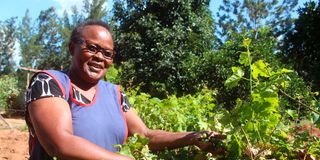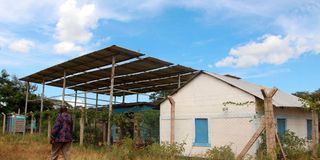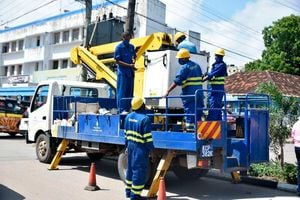Solar power provides answer to Makueni’s clean water dream

Berita Kilongosi, a resident of Kiatine in Makueni, harvests grapes at her farm on March 12. She is among the beneficiaries of a community water project that is powered by solar
What you need to know:
- The solar-powered Kaiti/Kamunyii water project serves about 10,000 residents spread across five villages. It is the only source of water in this region.
- The county government has so far pumped Sh32 million into the project, whose key features include an integrated energy plan that entails electricity, diesel generator and solar system.
On a sweltering Thursday afternoon in Kiatine Village,Makueni County, Berita Kilongosi waters luxuriant citrus and mango seedlings in a small nursery tucked behind her main house. She is using a hose pipe hooked to a tap standing at one corner of the homestead. Until three months ago, the 62-year-old mother of four could not think of the enterprise because water was hard to find. She was among villagers who trekked for at least six kilometres daily to draw water from shallow wells. Sometimes she paid vendors Sh20 per jerrican to deliver the commodity.
But things have since changed for Ms Kilongosi and dozens of her neighbours following the completion of an innovative water project, which is powered by sun.

A man walks past solar panels that power the Kaiti/Kamunyii water project in Makueni.
Residents in the area remained unfazed as the country reeled under a heatwave which peaked in February. “When the sun shines brightest, we are assured of water supply. We are not bothered by the prevailing heatwave because we bathe twice a day,” Ms Kilongosi said as she showed Health Nation around one of the family’s three overhead shower systems.
“We have more water than we need to meet our domestic needs. And it is highly affordable. A cubic metre costs Sh100. This means Sh2 per 20 litres. This is a dream come true”.
Some three kilometres away at the confluence of rivers Kaiti and Kamunyii, a sea of dry sand bed covers two underground tanks forming the heart of the innovative water project, which is hinged on the county’s aggressive sand conservation drive. The water tanks buried under sand hold 100 cubic metres each at any one point.
“Kaiti/Kamunyii water project serves about 10,000 residents spread across five villages and three schools. This is the only source of water in this region. We pump water at a rate of 18,000 litres per hour. We have started doing individual connections. Some 100 people have already connected water to their homesteads. We encourage individuals to invest in water tanks to avoid fluctuations in supply,” said Paul Mwanza, the chairman of the project’s sustainability committee.
The project consists of a sand dam constructed at the confluence of the two seasonal rivers by the national government in 2002. The county government picked it up at the advent of devolution. According to Mr Mwanza, the county government has so far pumped Sh32 million into the project, whose key features include an integrated energy plan that entails electricity, diesel generator and solar system. The project sits prominently at the centre of a broader plan by Governor Mutula Kilonzo Junior-led administration to address water shortage in the semi-arid region.
The devolved unit has embarked on increasing access to water from the current 46 per cent, as shown in the latest Makueni County Integrated Development Plan, to 75 per cent by 2025.
The multi-pronged approach to address water shortage in the county entails building new dams and boreholes, attracting national government agencies, non-governmental organisations and private investors to invest in the water sector, rehabilitating existing water projects such as sand dams and water pans, and adding value to complete water projects through distributing the commodity to the last mile, as well as enhancing the proper management of the existing water sources.
“The water sector is focusing on sustaining economic gains for inclusive development by implementing the last mile water infrastructure programme. This programme involves extending water supply to the household compounds where possible or reducing the distance to the nearest water source from the current four kilometres to within two kilometres.
“The government will promote and encourage individual household water connections through the existing registered water service providers. This initiative will increase the proportion of rural households accessing piped water from 30 per cent to 50 per cent and urban households from 7,939 in 2022 to 10,920 in 2025,” Mr Kilonzo Jnr told a recent development forum.
At the centre of the water distribution plan is deployment of green energy. Makueni County government has embarked on phasing out diesel generators in all the 462 boreholes, 327 earth dams and 219 sand dams, replacing them with solar panels in a move aimed at enhancing the sustainability of the projects while significantly cutting down on greenhouse gas emissions.
“We have realised that it is cheaper to install solar panels to power our water projects than it is to connect them to electricity. We are a privileged lot because we enjoy long hours of sunshine in this region. We shall tap it,” Mr Kilonzo Jnr said recently when he toured Kwa Mbila Dam, a flagship project that earned the county government praise from development experts in 2018 when the county hosted governors for a forum on public participation. The volume of water distribution at the dam, which serves more than 13,500 people spread across Kathonzweni and Kitise/Kithuki wards, increased significantly after the government replaced a diesel generator with a solar system.





